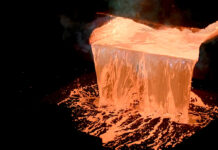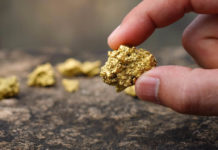
[miningmx.com] – THE cost of buying gold production in order to replenish pipelines is going up even though the value of dollar traded bullion has fallen 12.7% in the last 12 months and 39% in three years.
North American gold miner, Kinross, bought the Round Mountain and Bald Mountain mines in Nevada from Barrick for $720m on November 12 even though analysts thought the mines were worth much less – some $300m less in the estimation of BMO Capital Markets.
In August, AngloGold Ashanti sold its Cripple Creek & Victor mine in the US to Newmont Mining for $820m, enough to mean it no longer required any other asset sales to clear excess debt off its balance sheet. It was deemed “the deal of the year’ by Mark Bristow, whose Randgold Resources is in joint venture with AngloGold in the Congo.
According to Nick Holland, CEO of Gold Fields, gold majors are willing to pay heavy premiums because there has been a dearth in exploration over the years and it’s therefore difficult to find replacement ounces.
“The processes that you have to go through to do those disposals is very competitive,” said Holland when asked if his company was looking to participate in more merger and acquisition activity in the gold market.
In 2013, Gold Fields bought the Yilgarn South, assets in Australia, from Barrick Gold for $300m, a transaction that Holland said would deliver payback any day soon some two years after acquisition. He doubted it was possible to get those deals away at that price in today’s market, however.
“There are a lot of companies at the table and people are willing to pay up,” said Holland. “It tells you that companies are struggling to replace their pipelines because exploration has been slashed; no-one has a greenfields budget.
“Paradoxically, the cost of buying additional ounces of gold is going up at time when the gold price is going down,” he said.
SOUTH DEEP
Holland’s comments have a resonance in respect of progress at South Deep, the West Rand gold project his company has owned since December 2006.
The asset has 40 million reserve and 80 million gold resource ounces giving it a life of mine of 70 years – worth 47% of Gold Fields base case valuation, according to Allan Cooke and Abhishek Tiwari, analysts at JP Morgan Cazenove.
However, production has been cut back heavily at South Deep whilst Holland refocuses a new team at Gold Fields on re-engineering the mining process.
Holland acknowledged there might be shareholder frustration as Gold Fields sought a way to mine South Deep properly, last expected to produce 650,000 to 700,000 oz/year by 2017 but which currently has a full-year output guidence of 190,000 oz.
“I can appreciate the frustration when the mine has missed long-term targets for a number of times. But we need to look at value proposition on the table,” he said. “We would like another year with team to get better resolution,” he said.
But the doubters have already voiced their concerns over South Deep.
“South Deep remains challenging and, given the setbacks it has faced over the last 12 months, we believe production will struggle to reach guidance … which we think the stock continues to price,” said Goldman Sachs following a 17% increase in Gold Fields’ share price on November 19 following publication of its September quarter figures.










